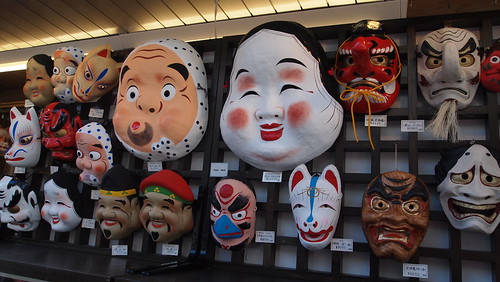
I love Japanese art and culture. Almost everything about the country - from buildings to gardens, displays, products, advertisements, food, shops, train stations and people (especially people) - are enchanting.
While Japan does have its share of woes (don't we all?), few countries around the world are able to balance age-old tradition with modernity in such a harmonious fashion. This is especially true in the field of aesthetics and design, where almost everything in Japan is well conceived. You can hardly find an eyesore there!
After doing some research, I found this interesting post by Japan Talk on the "9 Principles of Japanese Art and Culture" and a similar entry on Wikipedia about Japanese aesthetics. Reflecting upon my recent trip to Japan, I found that these precepts do ring somewhat true.
Let me now share these "truths" with some expansion, illustrated with photos from my trip.
1. Wabi-sabi 佗寂
The philosophy of Wabi-sabi is one of imperfection, impermanence and incompletion. In a sense, the very ephemeral nature of phenomena like Sakura (cherry) blossoms in spring or Koyo (red, yellow and orange leaves) in autumn are aspects of this value. Asymmetry, simplicity and modesty are also aspects of this value.

These masks in a shop at Asakusa reflect the aesthetic of wabi-sabi.

The ephemeral nature of dazzling red and orange leaves of maple trees in Arashiyama are a reflection of wabi-sabi.
2. Miyabi 雅
Miyabi is about elegance, refinement and courtliness. It is about the elimination of anything vulgar or unsightly. Anybody who has visited Japanese toilets (don't we love them?) would appreciate how they sanitise the process of "cleaning up" so much more pleasant. The politeness, etiquette and helpfulness of Japanese people are also a reflection of miyabi.

Elegant ladies in their kimonos below a willow tree in Maruyama Park in Kyoto.

Isn't a sashimi spread like this the epitome of refinement?
3. Shibui 渋い or Shibusa 渋さ
The aesthetic ideal behind shibui is one of simplicity, subtlety and unobtrusiveness. Hayao Miyazaki's anime movies like Spirited Away and Kiki's Delivery Service are a reflection of shibui, with their simple and subliminal storylines. Indeed, things that are less "in your face" are often far more pleasing and attractive than those that shout out loud.

This innocuous looking ticketing counter at Ghibli Museum (Mitaka, Tokyo) conceals a charming "ticketer".

Fallen red maples leaves in the former house of a Samurai in Nikko.
4. Iki 粋
Iki is often compared to its older and more universal cousin wabi-sabi. While it is about simplicity and temporality, iki is also about originality, uniqueness and spontaneity that is more audacious and unselfconscious while still remaining measured and controlled. If you think about the "Japanese punks" with their spiky colourful hair (yet mostly behaving themselves), they are a reflection of iki.

Creating your own cup noodle at Nissin's Ramen Noodle Museum is iki in action.

I've always found Nara's openly roaming deers a novel idea.
5. Jo-ha-kyū 序破急
Jo-ha-kyū is the concept of modulation and movement. It is sort of like a tempo in how you do things and means that all things should begin slowly, build up quickly to a rising crescendo, and then up swiftly. This idea is used by Japanese traditional arts such as tea ceremony and martial arts. Many Japanese movies and books (eg Haruki Murakami) build upon this aesthetic.

Neon coloured advertising billboards at Akihabara, Tokyo.

These okonimyaki chefs at Odaiba know a thing or two about jo-ha-kyū.
6. Yūgen 幽玄
Yūgen is a concept that values mystery and concealment. There is an element of profound depth with questions that may remain unanswered even as the plot unravels. The holding back of some of the answers is a common trait in much of Japanese theatre, movies, and books, and is quintessentially yūgen in practice.

A beautiful two-headed dragon partially buried in sand at Kodaiji Temple, Kyoto.

This deity shrouded in a satin red hood was found outside the main hall of Todaiji temple, Nara.
7. Geidō 藝道
This concept is embodied in the discipline, ethics and systematised approach to apprenticeship embodied in many Japanese traditional arts. These can be as varied as sushi making to Kendo and Sumo wrestling. Just think about the Japanese obsession with quality and high standards to see this in practice.

A takopachi chef in Dotobori (Osaka) displaying the fruits of geidō.

I've never seen people queue up in as disciplined a fashion as the Japanese at train stations!
8. Ensō 円相
Ensō is represented by a circle that symbolises a holistic form of absolution, enlightenment, strength, elegance, the Universe and the void. This Zen Buddhism concept is represented by a form of minimalism common in Japanese design and aesthetics. I'd like to think that ensō is about achieving a kind of completeness in a circle of life which is ever flowing

The home of the Japanese imperial family in Nikko is a reflection of minimalism.

Kegon Falls in Nikko. Somehow or other, I find that nature embodies ensō very well.
9. Kawaii かわいい
Naturally, this is probably the most well understood aesthetic element of Japanese art, culture and design. Meaning lovable, cute or adorable, kawaii is found almost everywhere in modern Japan and an integral part of Japanese society. It is certainly one of the most prevalent qualities of modern day Japanese design, even down to construction sites!

Ice cream for sale at an inn in Nikko.

This little chick is apparently the mascot for Nissin Ramen noodles.

Temporary guardrails at a construction site in Kameoka City, Kyoto.Labels: aesthetics, art, culture, design, Japan, Japanese, marketing, packaging, society



















